
Their stormy
adventure beats movies for action
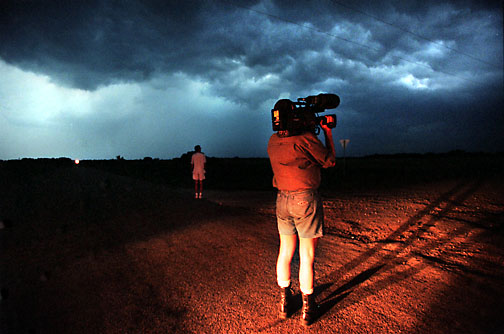
Geoff Mackley filming severe
storm clouds
just north of Gouda Springs,
Kansas

Their stormy
adventure beats movies for action

Geoff Mackley filming severe
storm clouds
just north of Gouda Springs,
Kansas
PONCA CITY, Okla. — A sunny afternoon can turn ugly real fast in Tornado Alley, and it’s about to.
On May 24 the atmosphere over north central Oklahoma and south-central Kansas is a weather bomb ready to go off. At 3:28 p.m. in Ponca City, a town that owes its prosperity to oil, not grain, it is a sticky 85 degrees. A hot 12 mph wind blows off the ocean of green wheat from the west. At 69, the dew point is excellent — lots of moisture hangs in the air, but not too much to drown a tornado’s delicate birthing process.
The sky over the Motel 8 is cloudless, but it is far from blue. It’s the color of dull pearls, an extremely unstable mix of highly energized air that serious tornado chasers like John Bender, Nancy Bose, Brian McNoldy and Dave Ott can get high just looking at.
The four were strangers, with only a common interest in bad weather and tornadoes, until they found each other on the Internet last year. Bose posted a desperate "I wanna go chase tornadoes" plea on the Storm Chasers Home Page.
Hundreds of e-mail messages later, the foursome and Geoff Mackley, a danger-seeking TV news cameraman from New Zealand on vacation who joined them, met each other in person four days ago in St. Louis. There they rented a Winnebago and drove into the heart of Tornado Alley during the height of tornado season.
Bender is the unofficial team leader. He’s a veteran storm spotter from northern Illinois who packed nearly $30,000 of radio and electronic gizmos into his Ford Escort, including a homemade lightning-strike detector he hoped to be able to test.
Bose, the team’s secretary-treasurer-cheerleader-tour guide and the catalyst of the trip, is a mother of teens and a car saleswoman from Verbank, N.Y., a few counties north of New York City. She’s been terrified/fascinated/nutty about tornadoes ever since she was 5, when she had to hide from one in a storm cellar on her parents’ Michigan farm.
McNoldy, the youngest team member at 22, is a 1998 graduate of Lycoming College from Reading, Pa., who has a degree in physics and astronomy. And Ott, 39, is a cattle farm-grown former commercial airplane pilot who owns two Subway outlets in Dickinson, N.D.
The chase team’s real-life adventure won’t resemble anything as exciting or dangerous, or as ludicrous, as the movie "Twister," which made finding a tornado in Oklahoma look as easy as finding a cloud in Pittsburgh. In fact, their odds of catching a tornado are almost as slim as the average American’s chances of being hit by one, even in Tornado Alley.
Notwithstanding "Twister," the nightly network news reports or Western Pennsylvania’s recent brush with funnel clouds, tornadoes are rare beasts. The 100,000 or so thunderstorms in the United States each year spawn only about 1,100 tornadoes, most of which occur in the spring in Texas, Oklahoma, Florida and Kansas.
Most are relatively weak, kill no one and do little more than tear up wide swatches of wheat fields in sparsely populated places like Kansas, a state twice the size of Pennsylvania but with 9 million fewer people. Only about 20 a year are so-called "killer tornadoes" like the super-powerful one that took 32 lives and destroyed Pleasant Grove, Ala., on April 8.
Bender, Bose, McNoldy and Ott will each spend 10 days and $1,500 on
their trip. They will drive almost 3,000 miles in four states trying to
get as up-close-and-personal to a twister as they safely can. And thanks
to their sharp bad-weather predicting skills, good teamwork and a little
luck, Bender, Bose, McNoldy and Ott will find themselves closer than they
should be to a tornado after only three days on the road.
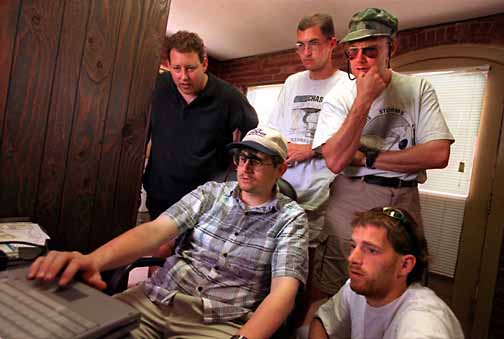
The team use the Internet
to tap into local weather radar sites. The team’s RV is also
crammed with radio and electronic gear.
The hottest time of the day is 4 p.m., when towering thunderstorms can begin exploding out of the sun-baked Great Plains like atomic cotton balls. Sure enough, by 4:51 p.m. May 24, a tornado watch is already posted in northwest Kansas.
An hour later, a southeast-bound train of thunderstorms is forming along a 200-mile weather front across Kansas where cold and warm air masses are bumping, rubbing and shoving against each other.
In the chasers’ motel rooms in Ponca City in north-central Oklahoma, the Weather Channel’s lead story at 6 p.m. shows the ominous line of swelling green corpuscles with their angry yellow-red centers. It’s angling right at the chasers. The team’s decision that morning to drive south to Ponca City from Emporia, Kan., and not chase any other storm clouds they saw along the way, makes them look like geniuses. They are directly in the path of the most severe weather in the whole country, and they love it.
But relying solely on the Weather Channel is for laymen, not self-taught meteorologists like quiet John Bender. He’d rather check out Internet sites showing CAPE data (convective available potential energy) than sleep. He’s in the chasers’ rented Winnebago, staring into a laptop connected to a web site showing Doppler radar from Wichita, 70 miles northwest.
Bender, 52, is a 25-plus year member of his hometown’s chapter of SKYWARN, the national organization of volunteer weather spotting groups that works with the National Weather Service. He’s an expert at reading his Doppler: red pixels (showing wind and rain going away from the radar source) next to green pixels (showing wind and rain coming at the radar source) indicate that a tornado is probably present, either in the air or on the ground.
Two nights before, in Medicine Lodge, Kan., Bender had his laptop hooked
to a Doppler radar site in Goodland, Kan. He pointed to a pairing of red-green
pixels on the screen and said it was most likely a tornado. Soon after,
the Weather Channel reported that a tornado had been spotted on the ground
near the area Bender had been pointing to.
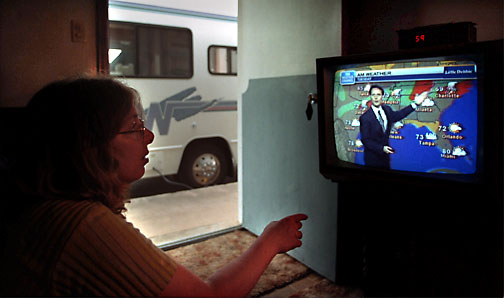
With the motor home hooked
up to a motel room’s power and telephone lines, Bose checks out the Weather
Channel. When deciding where to go for bad weather, however, the team used
more sophisticated sources.
About 6, Bender and McNoldy, who is studying for a master’s degree in atmospherics at Colorado State University, are watching a small storm cell forming 40 miles to the northwest. The cell is growing rapidly. The team meets and decides to try to intercept it. A route is planned, and by 6:30 the Escort heads due north on Route 77 toward the Kansas border, its roof bristling with four antennas, with the Winnebago following close behind.
Bose is driving the Escort. Bender is in the front passenger seat, laptop in his lap. He’s holding up an Internet-grabbing cellular phone, looking at radar sites. He’s listening to weather bulletins on both AM radio and his scanners. He’s also watching the rapidly darkening western sky.
At 6:51, Dave radios from the Winnebago that "our" cell is just to the west. The AM radio is a constant crackle of static from lightning that has been invisible so far. Passing through Newkirk, Okla., the tornado-casual townspeople are seemingly oblivious to the approaching apocalypse. They are doing their gardening, loading pickup trucks, sitting on their front stoops and porches.
Cars coming the other way have their lights on. All blue sky has disappeared. There is still no lightning. No rain. No hail. By the time the chasers cross the Kansas state line into Arkansas City and pass through the tiny town of Geuda Springs at about 7:30, AM radio out of Wichita is reporting tornadoes on the ground 15 miles to the west and northwest.
A mile north of Geuda Springs, on a slight hill in the middle of four wheat fields, the Escort and the motor home stop at Oxford Road and 110th Street. It’s an intersection the chasers will remember for the rest of their tornado-happy lives — an intersection that for severe-weather fiends like them will make their whole storm-chasing trip worthwhile.
Ott, McNoldy and Mackley pop out of the Winnebago, Mackley lugging his $25,000 TV news-cam and tripod. Bose is shooting her ancient video camera. A woman already there — the wife of a local storm spotter — warns everyone not to stand under the power lines because of the danger of lightning, yet she herself remains parked under them.
The nature show is spectacular. The north sky is angry, ugly, evil.
It’s a gray-black-green swirl of scary clouds — some wispy, some muscular,
some just hanging there, some rotating or moving upwards.

A tornado spotter returns
after taking a closer look at a storm cell passing near Geuda Springs,
Kansas.
Cloud-to-cloud lighting flashes. Thunder booms. The northern horizon is stabbed again and again by vicious bolts of thick lightning. A stiff cold wind from the northeast whips the tough thigh-high wheat into waves. A lightning stroke hits a tree a half-mile away and sets it afire. Tornado-warning sirens can be heard from distant towns.
Directly north, six or eight miles away from the intersection, a distinct storm cell is moving to the southeast. Underneath the wall cloud of the cell, looking like the stem of a misty mushroom, is a slanting sheet of rain. Shrouded by that rain, Bender says, is a funnel cloud — maybe two.
A local tornado spotter drives in from the north. Funnel clouds have been sighted on the other side of that rain cloud. He tells everyone they shouldn’t be there and that there’s a shelter in Geuda Springs. At the intersection, though the sun will not set for another half hour, it is almost dark. The first splats of rain are falling.
McNoldy and Bender, who would later say that they had inadvertently broken the rules of safe tornado chasing by punching in too close to the storm’s center, are studying the heavens for signs that a funnel cloud might be forming right above them. If one were to materialize, it would be on top of them in an instant and would probably be invisible until it picked up dirt and debris from the ground.
McNoldy is looking at the contrast between the light and dark clouds, where updrafts are and where rotation might be. "I’d keep an eye on that," Bender tells him above the chatter of the car radios and scanners. "It could start coming this way real fast."
At 8:24 the tornado siren in Geuda Springs begins to wail. Lightning is flashing everywhere. The chasers turn their vehicles around so they’re headed for Geuda Springs, where about 50 townspeople are in a shelter under the post office. With the wind picking up in wild, wicked bursts and a few fat raindrops blowing around like bullets, they have seen enough. It’s time to retreat.
Driving through Geuda Springs, however, Bose gets lost on the town’s only side street. Then she’s stopped for speeding by the town’s boyish assistant police chief, John Tyler. The wind and siren are howling and a deluge is on its way, but Bose is unable to find her driver’s license. With the local universe about to end, Tyler gives up and tells her to bring it to his office tomorrow. In Kansas, fleeing a tornado is not an excuse for going 43 in a 30 mph zone.
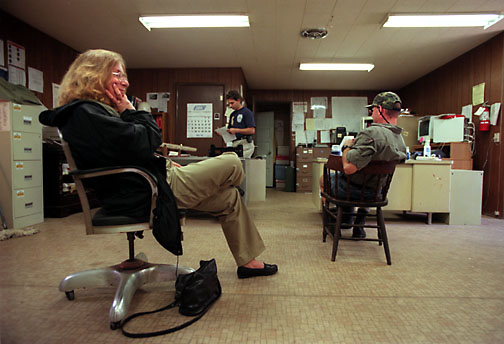
By the time Bose and Bender catch up with the Winnebago, the storm is raging in full fury. Visibility is near zero. Sheets of rain are being blown parallel to the ground. Water is ponding on the roads. The radio is reporting tornadoes to their north and east. Thirty miles west of Ponca City, near Lamont, Okla., a half-dozen homes and barns are being smashed by a tornado almost half a mile wide.
Parked in the storm of their lifetimes along a dark country road west
of Arkansas City, the chase team has no idea where the funnels are, just
that they are all around them. More are coming their way.
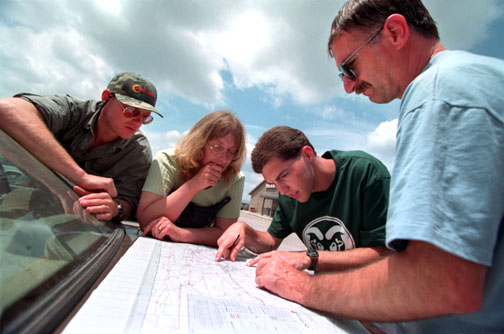
The team tries to decide
where the worst weather will be by late afternoon. Left to right, Geoff
Mackley, Nancy Bose, Brian McNoldy and John Bender.
GEUDA SPRINGS, Kan. -- Some people run from their childhood demons. Nancy Bose chases hers.
That means chasing tornadoes across four states for 10 days with a bunch of men she's never seen before.
Chasing tornadoes for fun is why Bose finds herself parked on a dark country road in south-central Kansas on a Sunday night in late May. She's caught in the middle of a chain of thunderstorms while several tornadoes spin somewhere not far to the north and east. She couldn't be happier.
Bose's long-ago exorcised childhood demon was a tornado that terrorized her when she was 5 and living on a farm in Michigan.
The twister sent her family scrambling to the storm cellar, just as the little girl and her family do in the opening scene of ''Twister'' -- which, by the way, caused Bose to nearly fall out of her seat with deja vu when she saw it.
Until she was in the sixth grade, whenever the most innocent thunderstorm brewed, Bose would beg her father to take their family -- and their pets and barnyard animals -- into the storm cellar. Slowly, however, her father -- Milber Givan, who lived in Mt. Lebanon during the late 1970s -- used scientific facts to turn her fear of storms into an avid interest in ''big weather.''
Bose is a car saleswoman for Chrysler, a mother of three and the wife of a very understanding corrections officer named Randy. She's a lively, smart, normal 46-year-old up-state New Yorker. It's just that two years ago she was afflicted with an unstoppable determination to take part in a tornado-chasing expedition.
Seeing the movie ''Twister'' showed her that chasing tornadoes was a
legitimate scientific activity -- and it made her desperately want to have
the experience before she got too old.
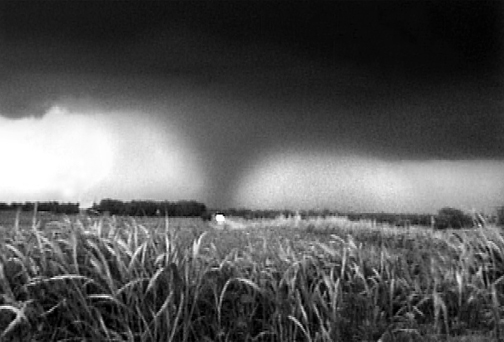
A funnel cloud -- invisible
in the rain except when backlit by lightning -- is caught in a single frame
of digital video as it passes about six miles north of the chasers.
After seeing ''Twister,'' Bose went to the Internet, posting a long, humorous, impassioned plea offering to serve for 10 days in any capacity as a volunteer on a tornado chase team.
It was answered by John Bender, 52, a self-taught bad-weather expert from northern Illinois who has been teaching volunteers to become community storm spotters for almost 30 years.
After months of e-mailing and planning, and after several chasers backed out at the last minute, Bender and Bose had set up a Missouri-Kansas-Oklahoma trip for late May, the height of tornado season. Two others, recent college grad Brian McNoldy and 39-year-old Subway franchiser Dave Ott, joined the team, along with a thrill-seeking TV news cameraman from New Zealand, Geoff Mackley.
Bose's preparations for the trip included designing T-shirts for the team that feature an illustration of a cow-tossing tornado and a phrase that nicely sums up the storm chasers attitude about weather: ''Nice Days Suck.''
At 9 p.m. on May 24, nothing is nice about what's going on in south-central Kansas. A long line of nasty thunderstorms is continuing to pound the flat, wide open spaces, where a few hulking grain silos and town water towers are the only landmarks above a sea of grain.
Since 7:10 five tornadoes have cut through the area. They include the rain-shrouded one that they were watching from the intersection north of Geuda Springs at 8:01, which passed about six miles away. At 8:45, another tornado was 10 miles to their east.
After fleeing the intersection, the chase team's vehicles, Bender's Ford Escort and a rented Winnebago, pull off a few miles south of Geuda Springs. The chasers are getting their bearings, listening to tornado warnings and waiting out the worst of the storm before going back to their hotel just across the state line in Ponca City, Okla.
Everyone in the team is enjoying the wild weather. Like Bose, Brian
McNoldy, the bright 22-year-old Lycoming College graduate from Reading,
Pa., is a life-long ''big weather'' fiend. As a kid, his mother used to
have to chase him away from the window during thunderstorms. A physics
and astronomy major at Lycoming, he's headed for a masters in atmospherics
and plans to be a storm researcher some day.
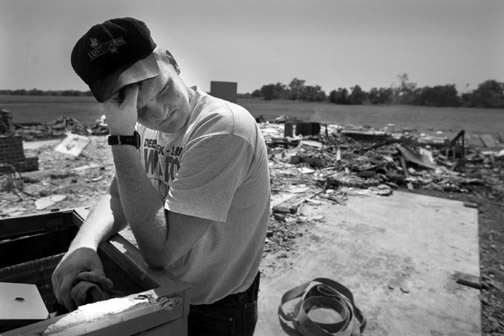
The brick home of Tim Wilkerson,
a police officer in Lamont, Okla., was destroyed May 24 by a tornado half-a-mile
wide that stayed on the ground for six miles. The twister — by far the
most powerful of 15 that sliced through north-central Oklahoma that night
— hurt no one but destroyed several houses and barns near Lamont, which
the tornado chasers visited.
Dave Ott, the linebacker-stocky 39-year-old owner of two Subway stores in Dickinson, N.D., is similarly fascinated. Growing up on a big farm in a state that sees maybe only 20 tornadoes a year, as a teen he watched a powerful twister go over his house and touch down 10 miles away, wiping out a neighbor's place.
A pilot who often takes his two teen-agers on local storm-chasing trips by car, he'd much rather be on the road in the middle of the action than sitting in a motel room staring at Doppler radar images and lift indexes on computer screens.
As for 35-year-old Geoff Mackley, the danger-chasing freelance TV news cameraman from Auckland, New Zealand, he treats ''big weather'' as just another opportunity to capture exciting video footage. A mountain climber/long-distance runner who eats yogurt and raisins all day, the only thing he's afraid of is the ingredients in American junk food and salsa.
Mackley's idea of a great time is to hike up a mountainside to the lip of an active volcano with his $25,000 video camera or fly into a tiny Pacific atoll a day before it's hit by a cyclone. His next mad adventure is flying on an experimental two-seat ultralight airplane from Auckland to London, England.
By 10 p.m. the chasers are safely back at their motel, which is being pummeled by high wind and heavy rain. New and nasty storm cells are still cruising toward Ponca City. A tornado slides by to the south, putting on an amazing lightning show that the chasers watch from under the eaves of the motel until 2 a.m.
The next morning, the chasers are up at 7:30 and reliving the thrill of the intersection. McNoldy says he saw a funnel cloud inside the rain wall twice, when it was backlighted by lightning; a frame of Bose's video confirms the funnel's presence.
Despite being nothing like anything in ''Twister,'' it had been a night that left no one disappointed.
''When I'm 90 years old I'll remember that intersection,'' Bose says,
speaking for everyone.
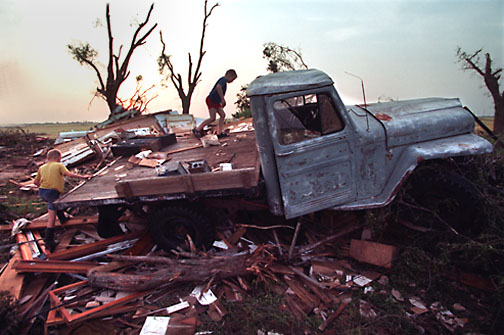
Lamont, Okla., two
children play in the ruins of their grandparents' home, which was unoccupied
when it was hit by a tornado May 24 Their grandparents salvaged what they
could.
McNoldy, who had seen his first tornado, is also psyched. For him, it was a night that will make the whole trip worthwhile, no matter what else happens.
''We were right in the middle of the action,'' he says, ''and the fact we chose that place 24 hours in advance was very impressive.'' Even more impressive, he says, ''We got out of that mess with the whole team and the vehicles intact. It was not a safe situation we were in.
''There were about five places that a tornado could have dropped out of the sky -- then we would have been in big trouble.''
In terms of tornado-spotting, the intersection at Geuda Springs turns out to be the highlight of the trip.
Amazingly, considering the awesome display of power nature put on, the National Weather Service office in Wichita says two weeks later that the five confirmed tornadoes on May 24 all were weak, short-lived and fairly typical for late spring in Kansas.
The tornadoes were officially classified as Force 0 on the Fujita Scale, which measures intensity by assessing the damage done to buildings, trees and cars. An F0, or gale tornado, has winds of only 40 to 72 mph, which may explain why the chasers can find virtually no evidence of damage the next day when they drive north from the intersection near Geuda Springs.
The next few days are uneventful. Following the cold front as it sags south, the chasers spend Monday night in Ada, Okla., and Tuesday night in Mount Pleasant, Texas. In both towns, they guess right and place themselves in the path of severe weather. But storms born in the afternoons in west Texas just miss them in the night or early mornings, and none contains tornadoes.
On Wednesday, the chasers trek north again to Norman, Okla., home of the Severe Storm Prediction Lab. It's a revered spot toured by about 100 storm chasers a month. Bose, Bender and McNoldy tour the premises even more religiously than when they visited Wakita, Okla., where much of ''Twister'' was filmed, the previous Saturday.
By Thursday, with the bad-weather zone way up north in Nebraska, the chasers visit Lamont, Okla., to see for themselves what kind of damage a Force 3 tornado can do.
Luckily, the F3 -- by far the biggest of a line of 15 mostly weak tornadoes
that hit northwest of the town Sunday night -- just missed the town. A
half-mile wide, staying on the ground for six miles and producing 153-
to 206-mph winds, it injured no one.
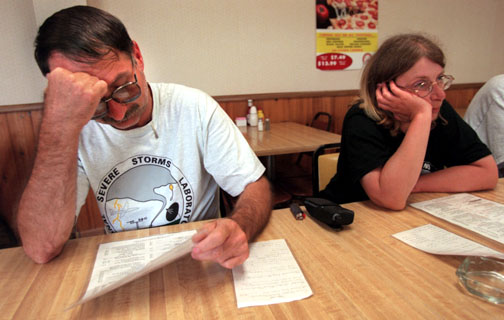
John Bender and Nancy Bose,
ordering lunch at a diner somewhere in Missouri, show the effects of nine
days of storm chasing. They’ve been on the road since 5:30 a.m.
But it easily moved cars 250 feet, toppled dozens of cemetery headstones and destroyed and scattered the contents of several brick houses and barns. A double-wide trailer was picked up, smashed into thousands of small pieces and scattered across a field of flattened wheat, leaving only a bare spot on the lawn, a bouquet of electrical wires coming out of the ground and a wood front deck with flower pots still on the railings.
The chasers take plenty of photos, but they approach the destruction like scientists, not gawkers. They agree that it was educational to have seen it. ''It made it feel like it actually happened. I didn't just read about it in the paper,'' McNoldy says. ''You could actually see the people's stuff scattered around.''
The next morning, Friday, the chasers are back in the hunt, packing up and leaving their Emporia, Kan., motel rooms at 5:30 a.m. They are hoping to get in front of a storm front racing across northern Kansas toward Kansas City, Mo. They drive for hours, crossing into Missouri, until they realize it's fruitless and give up.
By mid-afternoon, they cruise into St. Louis, where they have to return the Winnebago and catch their flights home the next day. In a motel room, the chasers agree that their trip was a great success in every way and begin laying plans for next year.
Bose says wild horses won't keep her away, though she's first going to buy a better video camera and her own laptop. Bender is willing. McNoldy is committed. So is cameraman Mackley, if he doesn't fall into the mouth of Mount Vesuvius first.
The chasers pull out a copy of their favorite movie. Bose has seen it 13 times. McNoldy 40 to 50 times. But they want Mackley, who has been shooting video for a six-minute piece on the trip for New Zealand's TV Channel 3, to see ''Twister'' for the first time.
Mackley watches but is not too impressed. ''No movie can ever compete with the real thing,'' he says with his usual cheerfulness. ''Nature puts on the best show, by far. That's why I never watch volcano movies or twister movies. They're never as good as the real thing. If you want to see a tornado, you watch a documentary, with real ones, or you go out and find your own.''
Bill Steigerwald / Allan Detrich 14 June 1998